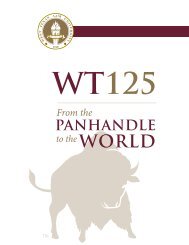The Economic Value of WTAMU Main Report
This report assesses the impact of West Texas A&M University (WTAMU) on the regional economy and the benefits generated by the university for students, taxpayers, and society. The results of this study show that WTAMU creates a positive net impact on the regional economy and generates a positive return on investment for students, taxpayers, and society.
This report assesses the impact of West Texas A&M University (WTAMU) on the regional economy and the benefits generated by the university for students, taxpayers, and society. The results of this study show that WTAMU creates a positive net impact on the regional economy and generates a positive return on investment for students, taxpayers, and society.
You also want an ePaper? Increase the reach of your titles
YUMPU automatically turns print PDFs into web optimized ePapers that Google loves.
Benefit-cost ratio<br />
<strong>The</strong> benefit-cost ratio is simply the present value <strong>of</strong> benefits divided by present<br />
value <strong>of</strong> costs, or $35,753 ÷ $21,500 = 1.7 (based on the 4% discount rate).<br />
Of course, any change in the discount rate would also change the benefit-cost<br />
ratio. Applying the 18.0% internal rate <strong>of</strong> return discussed above would reduce<br />
the benefit-cost ratio to 1.0, the breakeven solution where benefits just equal<br />
costs. Applying a discount rate higher than the 18.0% would reduce the ratio to<br />
lower than 1.0, and the investment would not be feasible. <strong>The</strong> 1.7 ratio means<br />
that a dollar invested today will return a cumulative $1.70 over the ten-year<br />
time period.<br />
Payback period<br />
This is the length <strong>of</strong> time from the beginning <strong>of</strong> the investment (consisting <strong>of</strong><br />
tuition and earnings foregone) until higher future earnings give a return on the<br />
investment made. For the student in Table A8.1, it will take roughly 4.2 years <strong>of</strong><br />
$5,000 worth <strong>of</strong> higher earnings to recapture his investment <strong>of</strong> $1,500 in tuition<br />
and the $20,000 in earnings foregone while attending the university. Higher<br />
earnings that occur beyond 4.2 years are the returns that make the investment<br />
in education in this example economically worthwhile. <strong>The</strong> payback period is<br />
a fairly rough, albeit common, means <strong>of</strong> choosing between investments. <strong>The</strong><br />
shorter the payback period, the stronger the investment.<br />
Appendix 8: Overview <strong>of</strong> Investment Analysis Measures<br />
100





